A Formal Approach to the Extraction of Permittivity and Permeability of Isotropic and Anisotropic Media Using the TM11 Mode in Rectangular Waveguides
Abstract
1. Introduction
2. Extraction Procedure
2.1. Description of the Configurations
2.2. Determination of Γ and P as Functions of S11 and S21
2.3. Extraction of Material Parameters Using z and Kz—Configuration A
2.4. Extraction of Material Parameters Using z and Kz—Configuration B
3. Simulations and Measurements
3.1. Description of the Configuration
- the isolation of signals from the external environment in a closed microwave path, and the possibility of using a smaller sample and its more precise positioning, compared to the so-called free-space methods; and
- the easier preparation of the sample in the form of a hexahedron, than of a cylinder in a coaxial line.
3.2. TM Mode Coax-to-Waveguide Adapter Design
3.3. Practical Implementation
3.4. Measurement Results
4. Discussion
- The first is due to the permittivity εr extraction resulting from (35). The traditional method requires first the determination of permeability μr, from (33), and then εr, from (34). The proposed method does not require the prior determination of permeability, so it does not introduce an additional error. In broadband studies, a known disadvantage of the NRW method is instability at frequencies corresponding to integer multiples of one-half wavelength in the MUT. An effective and widely used method of eliminating these instabilities is the iterative method, first described in [5]. This method applies to non-magnetic materials, i.e., with μr = 1. Using the TM11 mode does not require this assumption.
- When the medium is non-magnetic (which is a common case) and uniaxial, both relative permittivity εx, and εz can be determined using the TM11 mode without changing the position of the sample. This cannot be done with the TE11 mode, because the latter does not has an electric field z-component.
- In turn, the use of the TM11 and TE10 modes allows us to determine all four parameters of the uniaxial medium, without changing the position of the sample.
Author Contributions
Funding
Data Availability Statement
Conflicts of Interest
References
- Nicolson, A.M.; Ross, G.F. Measurement of the intrinsic properties of materials by time-domain techniques. IEEE Trans. Instrum. Meas. 1970, 19, 377–382. [Google Scholar] [CrossRef]
- Weir, W.B. Automatic measurement of complex dielectric constant and permeability at microwave frequencies. IEEE 1974, 62, 33–36. [Google Scholar] [CrossRef]
- Rothwell, E.J.; Frasch, J.L.; Ellison, S.M.; Chahal, P.; Ouedraogo, R.O. Analysis of the Nicolson-Ross-Weir Method for Characterizing the Electromagnetic Properties of Engineered Materials. Prog. Electromagn. Res. 2016, 157, 31–47. [Google Scholar] [CrossRef]
- Costa, F.; Borgese, M.; Degiorgi, M.; Monorchio, A. Electromagnetic Characterisation of Materials by Using Transmission/Reflection (T/R) Devices. Electronics 2017, 6, 95. [Google Scholar] [CrossRef]
- Baker-Jarvis, J.; Vanzura, E.J.; Kissick, W.A. Improved technique for determining complex permittivity with the transmission/reflection method. IEEE Trans. Microw. Theory Tech. 1990, 38, 1096–1103. [Google Scholar] [CrossRef]
- Smith, D.R.; Schultz, S.; Markoš, P.; Soukoulis, C.M. Determination of effective permittivity and permeability of metamaterials from reflection and transmission coefficients. Phys. Rev. B 2002, 65, 195104. [Google Scholar] [CrossRef]
- Markos, P.; Soukoulis, C.M. Transmission properties and effective electromagnetic parameters of double negative metamaterials. Opt. Express 2003, 11, 649–661. [Google Scholar] [CrossRef]
- Varadan, V.V.; Ro, R. Unique Retrieval of Complex Permittivity and Permeability of Dispersive Materials from Reflection and Transmitted Fields by Enforcing Causality. IEEE Trans. Microw. Theory Tech. 2007, 55, 2224–2230. [Google Scholar] [CrossRef]
- Chen, X.; Grzegorczyk, T.M.; Wu, B.-I.; Pacheco, J.; Kong, J.A. Robust method to retrieve the constitutive effective parameters of metamaterials. Phys. Rev. E 2004, 70, 016608. [Google Scholar] [CrossRef]
- Barroso, J.J.; de Paula, A.L. Retrieval of Permittivity and Permeability of Homogeneous Materials from Scattering Parameters. J. Electromagn. Waves Appl. 2010, 24, 1563–1574. [Google Scholar] [CrossRef]
- de Paula, A.L.; Rezende, M.C.; Barroso, J.J. Modified Nicolson-Ross-Weir (NRW) method to retrieve the constitutive parameters of low-loss materials. In Proceedings of the SBMO/IEEE MTT-S International Microwave and Optoelectronics Conference (IMOC 2011), Natal, Brazil, 29 October–1 November 2011; pp. 488–492. [Google Scholar] [CrossRef]
- Arslanagić, S.; Hansen, T.V.; Mortensen, N.A.; Gregersen, A.H.; Sigmund, O.; Ziolkowski, R.W.; Breinbjerg, O. A Review of the Scattering-Parameter Extraction Method with Clarification of Ambiguity Issues in Relation to Metamaterial Homogenization. IEEE Antennas Propag. Mag. 2013, 55, 91–106. [Google Scholar] [CrossRef]
- Angiulli, G.; Versaci, M. Retrieving the Effective Parameters of an Electromagnetic Metamaterial Using the Nicolson-Ross-Weir Method: An Analytic Continuation Problem Along the Path Determined by Scattering Parameters. IEEE Access 2021, 9, 77511–77525. [Google Scholar] [CrossRef]
- Chen, H.; Zhang, J.; Wang, Y.; Che, W.; Huang, Z.; Qiao, Y.; Luo, J.; Xue, Q. An Improved NRW Method for Thin Material Characterization Using Dielectric Filled Waveguide and Numerical Compensation. IEEE Trans. Instrum. Meas. 2022, 71, 1–9, Art no. 8003009. [Google Scholar] [CrossRef]
- Damaskos, N.J.; Mack, R.B.; Maffett, A.L.; Parmon, W.; Uslenghi, P.L.E. The inverse problem for biaxial materials. IEEE Trans. Microw. Theory Tech. 1984, 32, 400–405, Erratum in IEEE Trans. Microw. Theory Tech. 1992, 40, 174. [Google Scholar] [CrossRef]
- Akhtar, M.J.; Feher, L.E.; Thumm, M. A waveguide-based two-step approach for measuring complex permittivity tensor of uniaxial composite materials. IEEE Trans. Microw. Theory Tech. 2006, 54, 2011–2022. [Google Scholar] [CrossRef]
- Chen, H.; Zhang, J.; Bai, Y.; Luo, Y.; Ran, L.; Jiang, Q.; Kong, J.A. Experimental retrieval of the effective parameters of metamaterials based on a waveguide method. Opt. Express 2006, 14, 12944–12949. [Google Scholar] [CrossRef]
- Ishizaki, T.; Kida, S.; Awai, I. A measurement method of material parameters for uniaxially anisotropic artificial dielectrics. IEICE Electron. Express 2010, 7, 810–816. [Google Scholar] [CrossRef]
- Xu, X. Double waveguide method to retrieve the electromagnetic parameters of biaxial anisotropic materials. Electron. Lett. 2018, 54, 5436. [Google Scholar] [CrossRef]
- Hasar, U.C.; Buldu, G.; Bute, M.; Muratoglu, A. Calibration-free extraction of constitutive parameters of magnetically coupled anisotropic metamaterials using waveguide measurements. Rev. Sci. Instrum. 2017, 88, 104702. [Google Scholar] [CrossRef]
- Hasar, U.C.; Buldu, G.; Barroso, J.J. Waveguide Method for Electromagnetic Parameter Extraction of Weakly Coupled Metamaterials. IEEE Microw. Wirel. Compon. Lett. 2017, 27, 851–853. [Google Scholar] [CrossRef]
- Jiang, Z.; Bossard, J.A.; Wang, X.; Werner, D.H. Synthesizing metamaterials with angularly independent effective medium properties based on an anisotropic parameter retrieval technique coupled with a genetic algorithm. J. Appl. Phys. 2011, 109, 013515. [Google Scholar] [CrossRef]
- Castanié, A.; Mercier, J.-F.; Félix, S.; Maurel, A. Generalized method for retrieving effective parameters of anisotropic metamaterials. Opt. Express 2014, 22, 29937–29953. [Google Scholar] [CrossRef] [PubMed]
- Dukata, A.; Susek, W. Transmission Parameters of an Anisotropic Layered Structure in the Waveguide. In Proceedings of the SPIE 11442, Radioelectronic Systems Conference, Jachranka, Poland, 20–21 November 2019. [Google Scholar] [CrossRef]
- Mason, S.J. Feedback Theory–Some Properties of Signal Flow Graphs. Proc. IRE 1953, 41, 1144–1156. [Google Scholar] [CrossRef]
- Mason, S.J. Feedback Theory–Further Properties of Signal Flow Graphs. Proc. IRE 1956, 44, 920–926. [Google Scholar] [CrossRef]
- Application Note 1364-1, Agilent De-Embedding and Embedding S-Parameter Networks Using a Vector Network Analyzer; Agilent Technologies, Inc.: Santa Clara, CA, USA, 2004.
- Pittella, E.; Piuzzi, E.; Russo, P.; Fabbrocino, F. Microwave Characterization and Modelling of PA6/GNPs Composites. Math. Comput. Appl. 2022, 27, 41. [Google Scholar] [CrossRef]
- Guo, Z.; Pan, G.; Hall, S.; Pan, C. Broadband Characterization of Complex Permittivity for Low-Loss Dielectrics: Circular PC Board Disk Approach. IEEE Trans. Antennas Propag. 2009, 57, 3126–3135. [Google Scholar] [CrossRef]
- Narayanan, P.M. Microstrip Transmission Line Method for Broadband Permittivity Measurement of Dielectric Substrates. IEEE Trans. Microw. Theory Tech. 2014, 62, 2784–2790. [Google Scholar] [CrossRef]
- Indrusiak, T.; Pereira, I.M.; Pontes, K.; Pereira, E.C.; Peixoto, G.G.; Migliano, A.C.; Soares, B.G. Hybrid carbonaceous materials for radar absorbing poly (vinylidene fluoride) composites with multilayered structures. SPE Polym. 2021, 2, 62–73. [Google Scholar] [CrossRef]
- Chen, Y.C.; Lin, H.C.; Lee, Y.D. The effects of filler content and size on the properties of PTFE/SiO2 composites. J. Polym. Res. 2003, 10, 247–258. [Google Scholar] [CrossRef]
- Yakubu, A.; Abbas, Z.; Ibrahim, N.A.; Fahad, A. The effect of ZNO nanoparticles filler on complex permittivity of ZNO-PCL nanocomposite at microwave frequency. Phys. Sci. Int. J. 2015, 6, 196–202. [Google Scholar] [CrossRef]
- Wu, C.; Liu, Y.; Lu, S.; Gruszczynski, S.; Yashchyshyn, Y. Convenient waveguide technique for determining permittivity and permeability of materials. IEEE Trans. Microw. Theory Tech. 2020, 68, 4905–4912. [Google Scholar] [CrossRef]
- Yashchyshyn, Y.; Derzakowski, K.; Wu, C.; Cywiński, G. W-band sensor for complex permittivity measurements of rod shaped samples. IEEE Access 2021, 9, 111125–111131. [Google Scholar] [CrossRef]
- Meng, X.M.; Zhang, X.J.; Lu, C.; Pan, Y.F.; Wang, G.S. Enhanced absorbing properties of three-phase composites based on a thermoplastic-ceramic matrix (BaTiO3+ PVDF) and carbon black nanoparticles. J. Mater. Chem. A 2014, 2, 18725–18730. [Google Scholar] [CrossRef]
- Krupka, J. Frequency domain complex permittivity measurements at microwave frequencies. Meas. Sci. Technol. 2006, 17, R55–R70. [Google Scholar] [CrossRef]
- Krupka, J. Microwave Measurements of Electromagnetic Properties of Materials. Materials 2021, 14, 5097. [Google Scholar] [CrossRef]
- Kiani, M.; Abdolali, A.; Tayarani, M. Rectangular Waveguide Characterization of Biaxial Material Using TM11 Mode. IEEE Trans. Instrum. Meas. 2022, 71, 8005615. [Google Scholar] [CrossRef]
- Dukata, A.; Susek, W. Comments on “Rectangular Waveguide Characterization of Biaxial Material Using TM11 Mode”. IEEE Trans. Instrum. Meas 2023. accepted for publication. [Google Scholar]


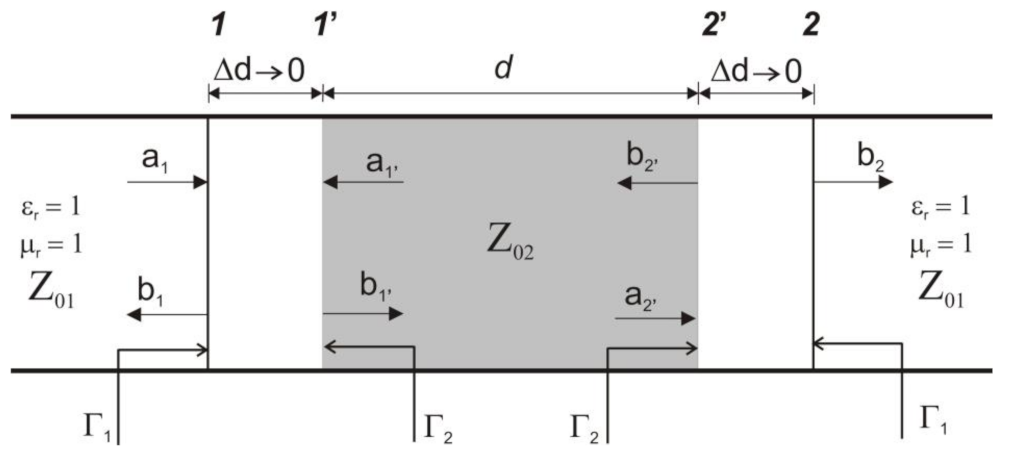
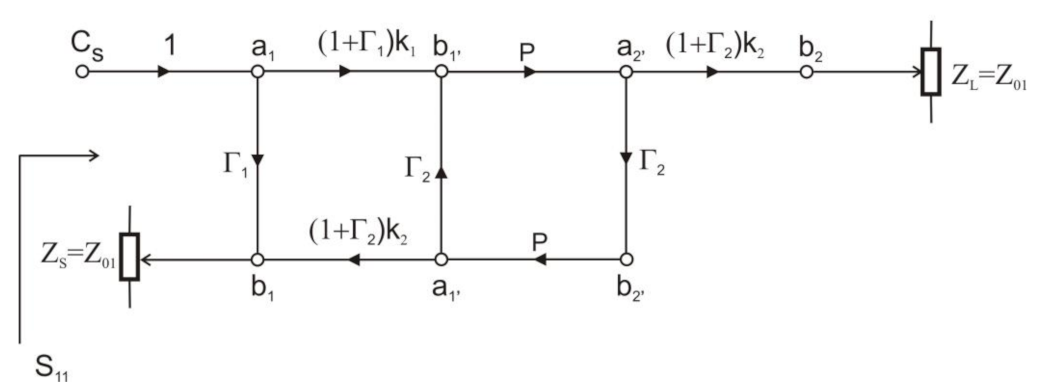
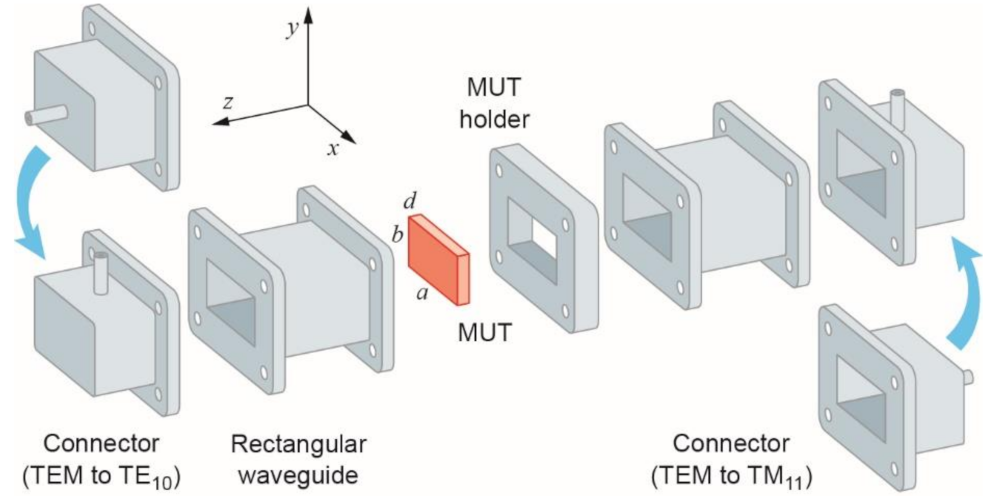
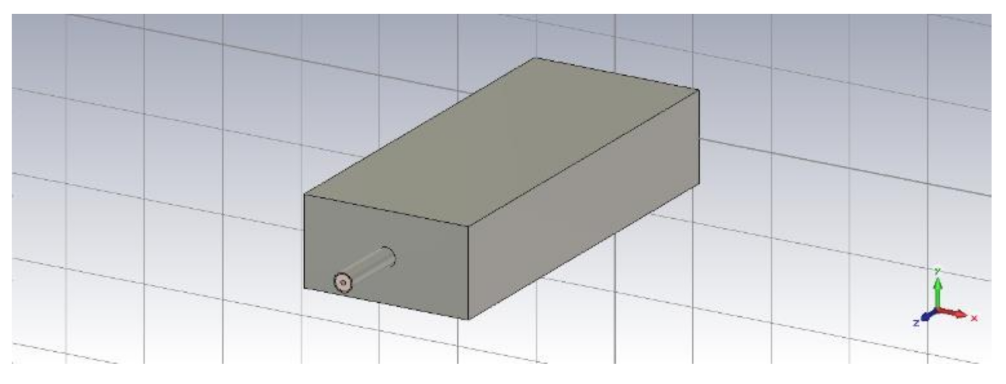
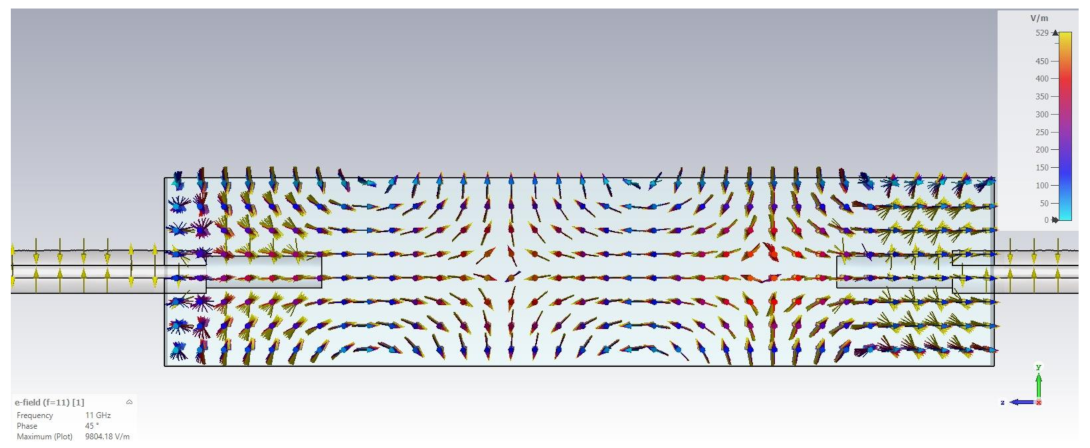
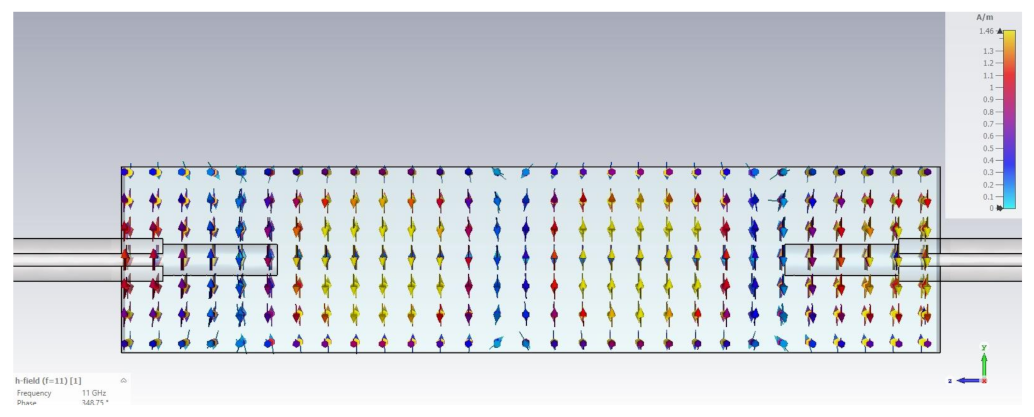
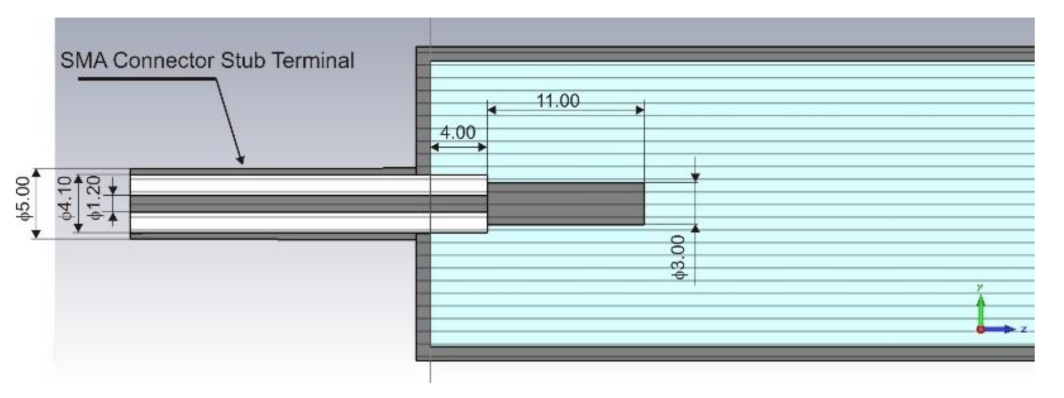
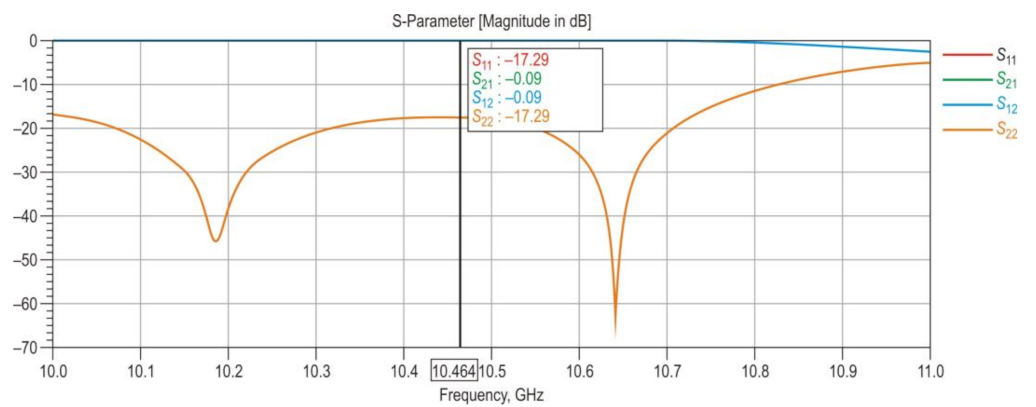


| Material | f [GHz] | ε′ | ε″ | tanδ 1 | μ′ | μ″ | Reference |
|---|---|---|---|---|---|---|---|
| PA-6 | 1.7–2.5 | 3.0723 ± 0.0095 | 0.0107 ± 0.0083 | - | - | − | [28] |
| 8.2–12.4 | 2.999 ± 0.0059 | 0.0091 ± 0.0045 | - | - | − | [28] | |
| FR4 | 4–12 | 4.4 | - | 2 × 10−2 | - | - | [29] |
| nominal | 4.2–5 | - | - | - | - | [30] | |
| 10 | 4.43 | - | - | - | - | [30] | |
| PVDF | 8–12 | 2.5 ± 0.5 | - | 1.0 ± 1.5 | 0.3 ± 2 | [31] | |
| PTFE | 8–13 | 2.046 ± 0.002 | - | - | - | - | [5] |
| 5 | 2.1 | 3.1 × 10−4 | [32] | ||||
| 8–12 | 2.01 ± 0.05 | 0.003 | - | - | - | [33] | |
| 9.816 | 2.06 | - | 2.1 × 10−4 | - | - | [34] | |
| 8–12 | 2.07 ± 0.3 | 0.003 ± 0.0004 | 1.02 ± 0.02 | 0.0 ± 0.002 | [35] | ||
| 70–114 | 2.12 | - | 3 × 10−4 | - | - | [35] |
| Material | dTM [mm] | S11 | S21 | ε′ | ε″ | μ′ | μ″ |
|---|---|---|---|---|---|---|---|
| PA-6 | 3 | 0.171 < −152° | 0.984 < −61.7° | 3.23 | 0.006 | 0.999 | 0.0002 |
| FR4 | 1.5 | 0.262 < −132.8° | 0.956 < −77.9° | 5.11 | 0.102 | 0.928 | 0.0023 |
| PVDF | 5 | 0.203 < −170.5° | 0.909 < −63.6° | 3.48 | 0.439 | 0.983 | 0.0220 |
| PTFE | 5 | 0.021 < 42.0° | 0.999 < −48.9° | 2.05 | 0.0028 | 1.110 | 0.00005 |
| Material | dTE [mm] | S11 | S21 | ε′ | ε″ | μ′ | μ″ |
|---|---|---|---|---|---|---|---|
| PA-6 | 3 | 0.449 < −134.2° | 0.892 < −44° | 3.23 | 0.008 | 0.999 | 0.0001 |
| FR4 | 1.5 | 0.432 < −125.5° | 0.892 < −34.1° | 5.12 | 0.102 | 0.998 | 0.004 |
| PVDF | 5 | 0.459 < −143.8° | 0.814 < −44.4° | 3.47 | 0.438 | 1.001 | 0.002 |
| PTFE | 5 | 0.239 < −121° | 0.970 < −30.9° | 2.06 | 0.002 | 0.998 | 0.0019 |
Disclaimer/Publisher’s Note: The statements, opinions and data contained in all publications are solely those of the individual author(s) and contributor(s) and not of MDPI and/or the editor(s). MDPI and/or the editor(s) disclaim responsibility for any injury to people or property resulting from any ideas, methods, instructions or products referred to in the content. |
© 2023 by the authors. Licensee MDPI, Basel, Switzerland. This article is an open access article distributed under the terms and conditions of the Creative Commons Attribution (CC BY) license (https://creativecommons.org/licenses/by/4.0/).
Share and Cite
Susek, W.; Dukata, A.; Pomarańska, P. A Formal Approach to the Extraction of Permittivity and Permeability of Isotropic and Anisotropic Media Using the TM11 Mode in Rectangular Waveguides. Electronics 2023, 12, 2899. https://doi.org/10.3390/electronics12132899
Susek W, Dukata A, Pomarańska P. A Formal Approach to the Extraction of Permittivity and Permeability of Isotropic and Anisotropic Media Using the TM11 Mode in Rectangular Waveguides. Electronics. 2023; 12(13):2899. https://doi.org/10.3390/electronics12132899
Chicago/Turabian StyleSusek, Waldemar, Andrzej Dukata, and Patrycja Pomarańska. 2023. "A Formal Approach to the Extraction of Permittivity and Permeability of Isotropic and Anisotropic Media Using the TM11 Mode in Rectangular Waveguides" Electronics 12, no. 13: 2899. https://doi.org/10.3390/electronics12132899
APA StyleSusek, W., Dukata, A., & Pomarańska, P. (2023). A Formal Approach to the Extraction of Permittivity and Permeability of Isotropic and Anisotropic Media Using the TM11 Mode in Rectangular Waveguides. Electronics, 12(13), 2899. https://doi.org/10.3390/electronics12132899













